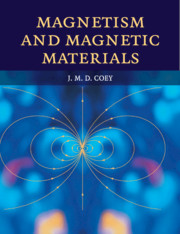Book contents
- Frontmatter
- Contents
- List of tables of numerical data
- Preface
- Acknowledgements
- 1 Introduction
- 2 Magnetostatics
- 3 Magnetism of electrons
- 4 Magnetism of localized electrons on the atom
- 5 Ferromagnetism and exchange
- 6 Antiferromagnetism and other magnetic order
- 7 Micromagnetism, domains and hysteresis
- 8 Nanoscale magnetism
- 9 Magnetic resonance
- 10 Experimental methods
- 11 Magnetic materials
- 12 Applications of soft magnets
- 13 Applications of hard magnets
- 14 Spin electronics and magnetic recording
- 15 Special topics
- Appendices
- Formula index
- Index
- Tables, conversions, constants and units
4 - Magnetism of localized electrons on the atom
Published online by Cambridge University Press: 05 June 2012
- Frontmatter
- Contents
- List of tables of numerical data
- Preface
- Acknowledgements
- 1 Introduction
- 2 Magnetostatics
- 3 Magnetism of electrons
- 4 Magnetism of localized electrons on the atom
- 5 Ferromagnetism and exchange
- 6 Antiferromagnetism and other magnetic order
- 7 Micromagnetism, domains and hysteresis
- 8 Nanoscale magnetism
- 9 Magnetic resonance
- 10 Experimental methods
- 11 Magnetic materials
- 12 Applications of soft magnets
- 13 Applications of hard magnets
- 14 Spin electronics and magnetic recording
- 15 Special topics
- Appendices
- Formula index
- Index
- Tables, conversions, constants and units
Summary
More matter, with less art.
Hamlet II iiThe quantum mechanics of a single electron in a central potential leads to classification of the one-electron states in terms of four quantum numbers. The individual electrons' spin and orbital angular momenta are coupled in an isolated manyelectron ion to give total spin and orbital quantum numbers S and L. Spin-orbit coupling then operates to split the energy levels into a series of J -multiplets, the lowest of which is specified by Hund's rules. Curie-law susceptibility, χ = C /T, is calculated for a general value of J. When placed in a solid, the ion experiences a crystal field due to the charge environment which disturbs the spin-orbit coupling, leaving either S or J as the appropriate quantum number. The crystal field modifies the structure of the lowest MS or MJ magnetic sublevels which are split by the Zeeman interaction and it introduces single-ion anisotropy.
Atomic physics is concerned with the energy levels of an atom or ion and the possible transitions between them, which are usually in the optical or ultraviolet energy range (1–10 eV). Magnetism is concerned with the energy levels that are occupied at ambient temperature, which usually means only the ground state, and its sublevels resulting from interactions with magnetic or electric fields, which produce a splitting of less than 0.1 eV. At ambient temperature kBT is about 25 meV.
- Type
- Chapter
- Information
- Magnetism and Magnetic Materials , pp. 97 - 127Publisher: Cambridge University PressPrint publication year: 2010



